Evaluation of Energy Transition Pathways to Phase out Coal for District Heating in Berlin
Abstract
1. Introduction
2. District Heating Network in Berlin
3. Methodology
4. Scenario Framework
4.1. Scenario Definition
- A reference scenario named “current policies”, assuming a continuation of currently implemented policies and measures. This scenario may lead to a situation where policy objectives (e.g., the share of renewables or the reduction in greenhouse gas emissions) cannot be reached.
- A scenario called “KS 80” (KS is an abbreviation of Klimaschutz (in German) meaning climate mitigation), assuming the adoption of policies and measures for reaching a reduction of 80% in emissions of greenhouse gases in 2050 relative to 1990.
- A scenario called “KS 95”, assuming the adoption of policies and measures for reaching a reduction of 95% in emissions of greenhouse gases in 2050 relative to 1990.
4.2. Model of the Electricity Market
4.3. Model of the Heat Demand
- In the Reference scenario, the current trends continue in the future. The rate of renovation would remain at 0.8% of buildings per year, while the living surface per capita would rise from 39 to 42 m2.
- The “Ziel 1” (Ziel meaning objective in German) scenario assumes a rate of renovation of 1.5% of buildings per year, while the current living surface per capita (39 m2) remains constant in the future.
- The “Ziel 2” scenario assumes a rate of renovation of 2.2% of buildings per year combined with a living surface per capita of 36 m2 in the future. This is further combined with the assumption that whenever a building is renovated, the renovation will lead to very high reductions in the energy demand for heating.
5. Evaluation of the Energy Potential from Different Sources
5.1. Biomass CHP/Heating Plant
5.2. Heat from Municipal Solid Waste (MSW) and Sewage
5.3. Industrial and Commercial Excess Heat
5.4. Geothermal Heat
5.5. Solar Thermal Heat
5.6. River Water Heat
5.7. Hybrid CHP Plant: Combining Power-To-Heat and a Gas-Based CHP
5.8. Overview
6. Model of the Heat Supply
6.1. Simulation of the Portfolio Feeding the District Heating Network
6.2. Simulation of Decentralized Supply Options
- -
- Decentralized gas engine CHP and boiler: A gas engine CHP coupled with a heat storage tank is dimensioned such that it generates electricity and heat in a fixed ratio throughout the year. An additional gas boiler supplements the heat supply on cold days when the heat needs cannot be covered exclusively by the CHP unit or when the CHP unit fails. The CHP unit generates approx. 60% of the heat on an annual basis.
- -
- Solar thermal unit and gas boiler: A solar thermal unit on the roof of an apartment building combined with a hot water storage tank generates 50% of the hot water supply and 13–17% of the space heating. The solar thermal unit generates about 13% of the heat in an old building and 17% in a new building. However, there is no seasonal storage due to lack of space in a densely built-up inner-city environment. The factor limiting solar thermal energy is the lack of seasonal storage, not the roof area. The gas boiler generates the rest of the required heat.
- -
- Air source heat pump, photovoltaic (PV) system, and gas boiler: An electrically-driven bivalent air source heat pump extracts ambient heat from the air and generates heat for hot water and space heating. The system is operated all year round and, in conjunction with a heat storage tank, generates 66% of the heat required. The PV system generates electricity, which is largely consumed by the heat pump. The gas boiler generates additional heat on particularly cold days.
6.3. Evaluation of Costs
- -
- Variable costs for generating heat subtracting the revenues from selling electricity for CHP plants.
- -
- Investments for new generation units and for the densification of the district heating grid (Figure 10). Investments costs were transformed into annuities over the technical lifetime of the generation units. For the calculation of the annuities, a weighted average cost of capital (WACC) was used, which was derived using a standard capital asset pricing model.
- -
- Variations in fixed costs (e.g., operating costs, staff costs) associated with the operation of new generation units or shut-down of old units.
6.4. Evaluation of Emissions
7. Results
7.1. Heat Generation
7.2. CO2 Emissions
7.3. Economic Analysis
8. Discussion
9. Conclusions
Author Contributions
Funding
Acknowledgments
Conflicts of Interest
Appendix A. Description of the Supply Area 1

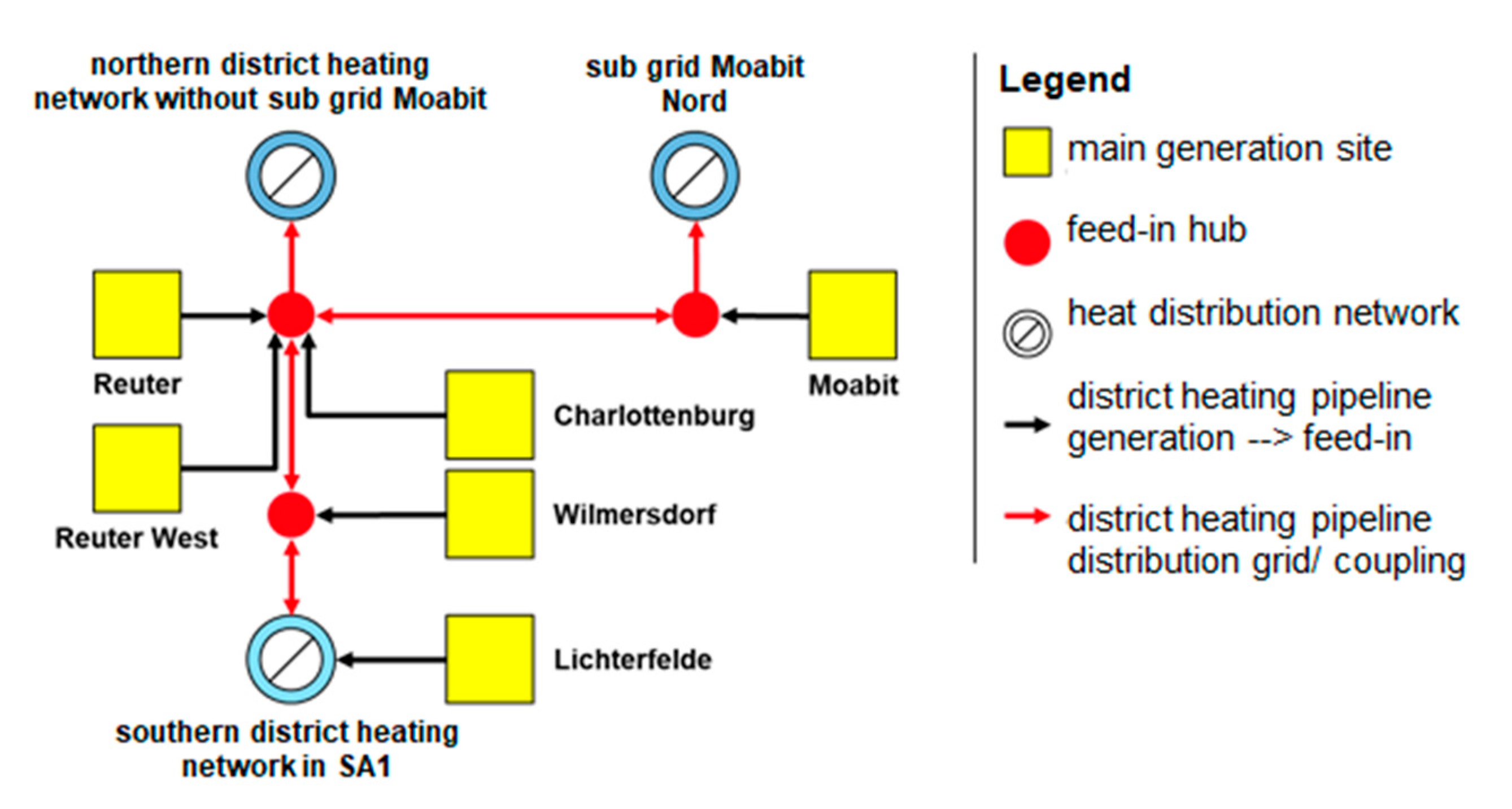
| Site | Technology | Energy Input | Electrical | Thermal |
|---|---|---|---|---|
| Reuter | Steam turbine CHP | MSW | 36 | 99 |
| Heat only boiler | Gas | 120 | ||
| Reuter West | Steam turbine CHP | Coal | 564 | 720 |
| Heat only boiler | Oil | 38 | ||
| Electric boiler (P2H) | Electricity | 120 | ||
| Moabit | Steam turbine CHP | Coal, biomass | 89 | 136 |
| Heat only boiler | Gas | 60 | ||
| Heat only boiler | Oil | 105 | ||
| Charlottenburg | Gas turbine CHP | Gas | 144 | 300 |
| Wilmersdorf | Gas turbine CHP | Gas | 194 | 110 |
| Heat only boiler | Gas | 120 | ||
| Lichterfelde | Gas turbine combined cycle CHP | Gas | 300 | 230 |
| Heat only boiler | Gas | 360 | ||
| Total | 1327 | 2518 |
Appendix B. Implications of the Different Scenarios
| Characteristics | Scenarios | |||
|---|---|---|---|---|
| KS 95 | KS 80 | Current Policies | ||
| General description | Highly ambitious climate protection policy | Less ambitious climate protection policy than KS 95 | Continuation of current policies | |
| Model of the energy market | GHG reduction in 2050 vs. 1990 (%) | 95 | 80 | 60 |
| Electricity demand in 2050 (TWh) | 750 | 680 | 620 | |
| Share of RES in power generation (%) | 96 | 88 | 83 | |
| CO2 price in 2050 (€/t) | 126 | 93 | 39 | |
| Model of the heat demand | District heating market penetration (%) | 60 | 60 | 40 |
| Renovation rate (%/year) | 2.2 | 1.5 | 0.6 | |
| Heat demand in SA1 in 2030 (TWh) | 4.7 | 5 | 4.7 | |
| Heat demand in SA1 in 2050 (TWh) | 3.9 | 4.8 | 5 | |
References
- Rogeli, J.; Shindell, D.; Jiang, K.; Fifita, S.; Forster, P.; Ginzburg, V.; Handa, C.; Kheshgi, H.; Kobayashi, S.; Kriegler, E.; et al. Mitigation pathways compatible with 1.5 °C in the context of sustainable development. In Global Warming of 1.5 °C: An IPCC Special Report on the Impacts of Global Warming of 1.5 °C above Pre-Industrial Levels and Related Global Greenhouse Gas Emission Pathways; Intergovernmental Panel on Climate Change (IPCC): Geneva, Switzerland, 2018. [Google Scholar]
- IRENA. Global Energy Transformation: A Roadmap to 2050; International Renewable Energy Agency: Abu Dhabi, UAE, 2018. [Google Scholar]
- IEA. Energy Technology Perspectives 2017: Catalyzing Energy Technology; International Energy Agency: Paris, France, 2017. [Google Scholar]
- Zappa, W.; Junginger, M.; van den Broek, M. Is a 100% renewable European power system feasible by 2050? Appl. Energy 2019, 233, 1027–1050. [Google Scholar] [CrossRef]
- Gerbaulet, C.; von Hirschhausen, C.; Kemfert, C.; Lorenz, C.; Oei, P. European electricity sector decarbonization under different levels of foresight. Renew. Energy 2019, 141, 973–987. [Google Scholar] [CrossRef]
- Samadi, S.; Lechtenbömer, S.; Prantner, M.; Nebel, A. Vollständig auf Erneuerbaren Energien Basierende Stromversorgung Deutschlands im Jahr 2050 auf Basis in Europa Großtechnisch Leicht Erschließbarer Potentiale—Analyse und Bewertung Anhand von Studien; Umwelt Bundesamt: Dessau-Roßlau, Germany, 2014.
- Capros, P.; Paroussos, L.; Fragkos, P.; Tsani, S.; Boitier, B.; Wagner, F.; Busch, S.; Resch, G.; Blesl, M.; Bollen, J. European decarbonisation pathways under alternative technological and policy choices: A multi-model analysis. Energy Strat. Rev. 2014, 2, 231–245. [Google Scholar] [CrossRef]
- Van Zuijlen, B.; Zappa, W.; Turkenburg, W.; van der Schrier, G.; van den Broek, M. Cost-optimal reliable power generation in a deep decarbonisation future. Appl. Energy 2019, 253, 113587. [Google Scholar] [CrossRef]
- Pleßmann, G. Modeling Decarbonization Pathways of Europe’s Electricity Supply until 2050. Ph.D. Thesis, Carl von Ossietzky Universität Oldenburg, Oldenburg, Germany, 2019. [Google Scholar]
- Kavvadias, K.; Jiménez-Navarro, J.; Thomassen, G. Decarbonising the EU Heating Sector; JRC Technical Reports; European Commission: Petten, The Netherlands, 2019. [Google Scholar]
- Jimenez-Navarro, J.; Kavvadias, K.; Filippidou, F.; Pavičević, M.; Quoilin, S. Coupling the heating and power sectors: The role of centralised combined heat and power plants and district heat in a European decarbonised power system. Appl. Energy 2020, 270, 115134. [Google Scholar] [CrossRef]
- Millar, M.; Burnside, N.; Yu, Z. District Heating Challenges for the UK. Energies 2019, 12, 310. [Google Scholar] [CrossRef]
- Helin, K.; Zakeri, B.; Syri, S. Is District Heating Combined Heat and Power at Risk in the Nordic Area?—An Electricity Market Perspective. Energies 2018, 11, 1256. [Google Scholar] [CrossRef]
- Pakere, I.; Lauka, D.; Blumberga, D. Does the Balance Exist between Cost Efficiency of Different Energy Efficiency Measures? DH Systems Case. Energies 2020, 13, 5151. [Google Scholar] [CrossRef]
- Blanco, I.; Guericke, D.; Andersen, A.; Madsen, H. Operational Planning and Bidding for District Heating Systems with Uncertain Renewable Energy Production. Energies 2018, 11, 3310. [Google Scholar] [CrossRef]
- Ko, S.; Lautala, P. Optimal Level of Woody Biomass Co-Firing with Coal Power Plant Considering Advanced Feedstock Logistics System. Agriculture 2018, 8, 74. [Google Scholar] [CrossRef]
- Sáez-Blázquez, C.; Martín, A.F.; Martín-Nieto, I.; González-Aguilera, D. Economic and environmental analysis of different district heating systems aided by geothermal energy. Energies 2018, 11, 1265. [Google Scholar] [CrossRef]
- Kauko, H.; Rohde, D.; Knudsen, B.R.; Sund-Olsen, T. Potential of thermal energy storage for a district heating system utilizing industrial waste heat. Energies 2020, 13, 3923. [Google Scholar] [CrossRef]
- Nielsen, S.; Hansen, K.; Lund, R.; Moreno, D. Unconventional excess heat sources for district heating in a national energy system context. Energies 2020, 13, 5068. [Google Scholar] [CrossRef]
- Kontu, K.; Vimpari, J.; Penttinen, P.; Junnila, S. City Scale Demand Side Management in Three Different-Sized District Heating Systems. Energies 2018, 11, 3370. [Google Scholar] [CrossRef]
- Lund, H.; Werner, S.; Wiltshire, R.; Svendsen, S.; Thorsen, J.E.; Hvelplund, F.; Mathiesen, B.V. 4th Generation District Heating (4GDH): Integrating smart thermal grids into future sustainable energy systems. Energy 2014, 68, 1–11. [Google Scholar] [CrossRef]
- Guzzini, A.; Pellegrini, M.; Pelliconi, E.; Saccani, C. Low Temperature District Heating: An Expert Opinion Survey. Energies 2020, 13, 810. [Google Scholar] [CrossRef]
- Neirotti, F.; Noussan, M.; Riverso, S.; Manganini, G. Analysis of different strategies for lowering the operation temperature in existing district heating networks. Energies 2019, 12, 321. [Google Scholar] [CrossRef]
- IEA. Germany 2020, Energy Policy Review; International Energy Agency: Paris, France, 2020. [Google Scholar]
- Bertelsen, N.; Mathiesen, B. EU-28 residential heat supply and consumption historical development and status. Energies 2020, 13, 1894. [Google Scholar] [CrossRef]
- Fehrenbach, D.; Merkel, E.; McKenna, R.; Karl, U.; Fichtner, W. On the economic potential for electric load management in the german residential heating sector—An optimising energy system model approach. Energy 2014, 71, 263–276. [Google Scholar] [CrossRef]
- Merkel, E.; McKenna, R.; Fehrenbach, D.; Fichtner, W. A model-based assessment of climate and energy targets for the German residential heat system. J. Clean. Prod. 2017, 142, 3151–3173. [Google Scholar] [CrossRef]
- Bauermann, K. German Energiewende and the heating market-Impact and limits of policy. Energy Policy 2016, 94, 235–246. [Google Scholar] [CrossRef]
- Bloess, A. Impacts of heat sector transformation on Germany’s power system through increased use of power-to-heat. Appl. Energy 2019, 239, 560–580. [Google Scholar] [CrossRef]
- Bernath, C.; Deac, G.; Sensfuß, F. Influence of heat pumps on renewable electricity integration: Germany in a European context. Energy Strategy Rev. 2019, 26, 100389. [Google Scholar] [CrossRef]
- Koch, K.; Höfner, P.; Gaderer, M. Techno-economic system comparison of a wood gas and a natural gas CHP plant in flexible district heating with a dynamic simulation model. Energy 2020, 202, 117710. [Google Scholar] [CrossRef]
- Popovski, E.; Aydemir, A.; Fleiter, T.; Bellstädt, D.; Büchele, R.; Steinbach, J. The role and costs of large-scale heat pumps in decarbonising existing district heating networks—A case study for the city of Herten in Germany. Energy 2019, 180, 918–933. [Google Scholar] [CrossRef]
- Persson, U. District Heating in Future Europe: Modelling Expansion Potentials and Mapping Heat Synergy Regions; Chalmers University of Technology: Gothenburg, Sweden, 2015. [Google Scholar]
- City of Berlin, Berliner Energiewendegesetz (EWG Bln). 2016. Available online: http://gesetze.berlin.de/jportal/?quelle=jlink&query=EWendG+BE&psml=bsbeprod.psml&max=true&aiz=true (accessed on 17 June 2020).
- BMUB. Climate Action Plan 2050. Principles and Goals of the German Government’s Climate Policy; Federal Ministry for the Environment, Nature Conservation, Building and Nuclear Safety (BMUB): Rosctock, Germany, 2016.
- Amt für Statistik. Energie- und CO2-Bilanz in Berlin 2017; Office for Statistics Berlin-Brandenburg: Potsdam, Germany, 2017.
- IRENA. Renewable Energy in District Heating and Cooling: A Sector Roadmap for Remap; International Renewable Energy Agency: Abu Dhabi, UAE, 2017. [Google Scholar]
- Fraunhofer IWES/IBP. Heat Transition 2030: Key Technologies for Reaching the Intermediate and Long-Term Climate Targets in the Building Sector; Agora Energiewende: Berlin, Germany, 2017. [Google Scholar]
- B E T; Vattenfall; SenUVK. Machbarkeitstudie Kohleausstieg und Nachhaltige Fernwärmeversorgung Berlin 2030; Büro für Energiewirtschaft und technische Planung (B E T); Vattenfall Wärme Berlin and Berlin Senate Department for the Environment, Transport and Climate Protection: Aachen, Germany, 2019. [Google Scholar]
- Talebi, B.; Mirzaei, P.; Bastani, A.; Haghighat, F. A Review of District Heating Systems: Modeling and Optimization. Front. Built Environ. 2016, 2, 22. [Google Scholar] [CrossRef]
- Werner, S. International review of district heating and cooling. Energy 2017, 137, 617–631. [Google Scholar] [CrossRef]
- Federal Ministry of the Environment, Nuclear Safety and Nature Conservation. German Climate Action Plan 2050: Principles and Goals of the German Government’s Climate Policy; Federal Ministry of the Environment, Nuclear Safety and Nature Conservation: Berlin, Germany, 2016.
- IEA. World Energy Model; International Energy Agency: Paris, France, 2019. [Google Scholar]
- IEA. Energy Technology Perspectives (ETP) Model; International Energy Agency: Paris, France, 2019. [Google Scholar]
- IEA-ETSAP. Documentation for the TIMES Model, Part III; International Energy Agency—Energy Technology Systems Analysis Programme (ETSAP): Paris, France, 2016. [Google Scholar]
- He, Y.; Hildmann, M.; Herzog, F.; Andersson, G. Modeling the Merit Order Curve of the European Energy Exchange Power Market in Germany. IEEE Trans. Power Syst. 2013, 28, 3155–3164. [Google Scholar] [CrossRef]
- Deane, P.; Collins, S.; Gallachóir, B.Ó.; Eid, C.; Hartel, R.; Keles, D.; Fichtner, W. Quantifying the "Merit-Order" Effect in European Electricity Markets; Rapid Response Energy Brief; Institut für Industriebetriebslehre und Industrielle Produktion (IIP): Karlsruhe, Germany, 2016. [Google Scholar]
- Howells, M.; Rogner, H.; Strachan, N.; Heaps, C.; Huntington, H.; Kypreos, S.; Hughes, A.; Silveira, S.; DeCarolis, J.; Bazillian, M.; et al. OSeMOSYS: The Open Source Energy Modeling System: An introduction to its ethos, structure and development. Energy Policy 2011, 39, 5850–5870. [Google Scholar] [CrossRef]
- IEA. World Energy Outlook (WEO); International Energy Agency: Paris, France, 2017. [Google Scholar]
- BCG & Prognos. Klimapfade für Deutschland; Boston Consulting Group and Prognos: Boston, MA, USA, 2018. [Google Scholar]
- Fraunhofer ISI, Consentec & IFEU. Langfristszenarien für die Transformation des Energiesystems in Deutschland—Modul 3: Referenzszenario und Basisszenario; Bundesministerium für Wirtschaft und Energie: Berlin, Germany, 2017.
- Öko-Institut & Fraunhofer ISI. Klimaschutzszenario 2050–2. Endbericht; Öko-Institut & Fraunhofer ISI: Berlin, Germany, 2015. [Google Scholar]
- PIK. Feasibility Study for a Climate-Neutral Berlin in 2050; Potsdam Institut für Klimaforschung, Institut für Ökologische Wirtschaftsforschung: Potsdam, Germany, 2014. [Google Scholar]
- SenUVK. Berliner Energie- und Klimaschutzprogramm 2030 (BEK 2030); City of Berlin, Senate Department for the Environment, Transport and Climate Protection: Berlin, Germany, 2017. [Google Scholar]
- Vattenfall. Moabit CHP Plant. Available online: https://powerplants.vattenfall.com/moabit (accessed on 25 May 2020).
- DBFZ. Biomass Resource Database for Germany. Deutsches Biomasseforschungszentrum (DBFZ). Available online: http://webapp.dbfz.de/resources (accessed on 4 May 2020).
- Brosowski, A.; Adler, P.; Erdmann, G.; Stinner, W.; Thrän, D.; Mantau, U.; Blanke, C.; Mahro, B.; Hering, T.; Reinholdt, G. Biomassepotenziale von Rest- und Abfallstoffen—Status quo in Deutschland (in German); Deutsches Biomasseforschungszentrum Gemeinnützige GmbH (DBFZ): Leipzig, Germany; Fachagentur Nachwachsende Rohstoffe e.V. (FNR): Gülzow, Germany, 2015. [Google Scholar]
- Brosowski, A.; Thrän, D.; Mantau, U.; Mahro, B.; Erdmann, G.; Adler, P.; Stinner, W.; Reinhold, G.; Hering, T.; Blanke, C. A review of biomass potential and current utilisation—Status quo for 93 biogenic wastes and residues in Germany. Biomass Bioenergy 2016, 95, 257–272. [Google Scholar] [CrossRef]
- BSR. Müllheizkraftwerk Ruhleben: Garant der Entsorgungssicherheit in Berlin; Berliner Stadtreinigung (BSR): Berlin, Germany, 2020. [Google Scholar]
- SenUVK. Geologischer Aufbau von Berlin; Senatsverwaltung für Gesundheit, Umwel und Verbraucherschutz Berlin (SenUVK): Berlin, Germany, 2018. [Google Scholar]
- Kahnt, R.; Ertel, S.; Feldmann, H.; Behnke, H. Potenzialstudien zur Nutzung der geothermischen ressource des Landes Berlin (Modul 2): Abschlussbericht zu den Ergebnissen; SenUVK: Berlin, Germany, 2011. [Google Scholar]
- Kastner, O.; Sippel, J.; Scheck-Wenderoth, M.; Huenges, E. The deep geothermal potential of the Berlin area. Environ. Earth Sci. 2013, 70, 3567–3584. [Google Scholar] [CrossRef]
- Kastner, O.; Sippel, J.; Zimmermann, G. Regional-scale assessment of hydrothermal heat plant capacities fed from deep sedimentary acquifers in Berlin/Germany. Geothermics 2015, 53, 353–367. [Google Scholar] [CrossRef]
- BVG. Tiefe Erdwärmesonden; Bundesverband Geothermie (BVG): Berlin, Germany, 2018. [Google Scholar]
- BVG. Wärmestromdichte; Bundesverband Geothermie (BVG): Berlin, Germany, 2018. [Google Scholar]
- Bloess, A.; Schill, W.; Zerrahn, A. Power-to-heat for renewable energy integration: A review of technologies, modeling approaches, and flexibility potentials. Appl. Energy 2018, 212, 1611–1626. [Google Scholar] [CrossRef]
- Perez-Arriaga, I.J.; Batlle, C. Impacts of Intermittent Renewables on Electricity Generation System Operation. Econ. Energy Environ. Policy 2012, 1, 3–17. [Google Scholar] [CrossRef]
- Gonzalez-Salazar, M.; Kirsten, T.; Prchlik, L. Review of the operational flexibility and emissions of gas- and coal-fired power plants in a future with growing renewables. Renew. Sustain. Energy Rev. 2018, 82, 1497–1513. [Google Scholar] [CrossRef]
- Hers, S.; Afman, M.; Cherif, S.; Rooijers, F. Potential for Power-to-Heat in the Netherlands; CE Delft: Delft, The Netherlands, 2015. [Google Scholar]
- EC. Mapping and Analyses of the Current and Future (2020–2030) Heating/Cooling Fuel Deployment (Fossil/Renewables); European Commission, Directorate General for Energy: Brussels, Belgium, 2016. [Google Scholar]
- Vattenfall. Power-to-Heat. 2020. Available online: https://group.vattenfall.com/de/zukunft/speichertechnologie/power-to-heat (accessed on 4 May 2020).
- Steag. EBSILON Professional. Available online: https://www.steag-systemtechnologies.com/de/produkte/ebsilon-professional (accessed on 4 May 2020).
- GAMS. General Algebraic Modelling System. GAMS Development Corporation. 2020. Available online: https://www.gams.com/latest/docs/UG_GAMSPrograms.html (accessed on 4 May 2020).
- IEA-ETSAP. Documentation for the TIMES Model, Part IV; International Energy Agency—Energy Technology Systems Analysis Programme (ETSAP): Paris, France, 2016. [Google Scholar]
- Christidis, A.; Koch, C.; Pottel, L.; Tsatsaronis, G. The contribution of heat storage to the profitable operation of combined heat and power plants in liberalized electricity markets. Energy 2012, 41, 75–82. [Google Scholar] [CrossRef]
- Christidis, A.; Mollenhauer, E.; Tsatsaronis, G.; Schuchardt, G.; Holler, S.; Böttger, D.; Bruckner, T. EnEff-Wärme: Einsatz von Wärmespeichern und Power-to-Heat-Anlagen in der Fernwärmeerzeugung; Technische Universität Berlin: Berlin, Germany, 2017. [Google Scholar]
- Gurobi. Gurobi Optimization LLC. 2020. Available online: www.gurobi.com (accessed on 4 May 2020).
- AGFW. Energetische Bewertung der Fernwärme—Bestimmung spezifischer CO2—Emissionsfaktoren; AGFW|Der Energieeffizienzverband für Wärme, Kälte und KWK e.V.: Frankfurt, Germany, 2016. [Google Scholar]
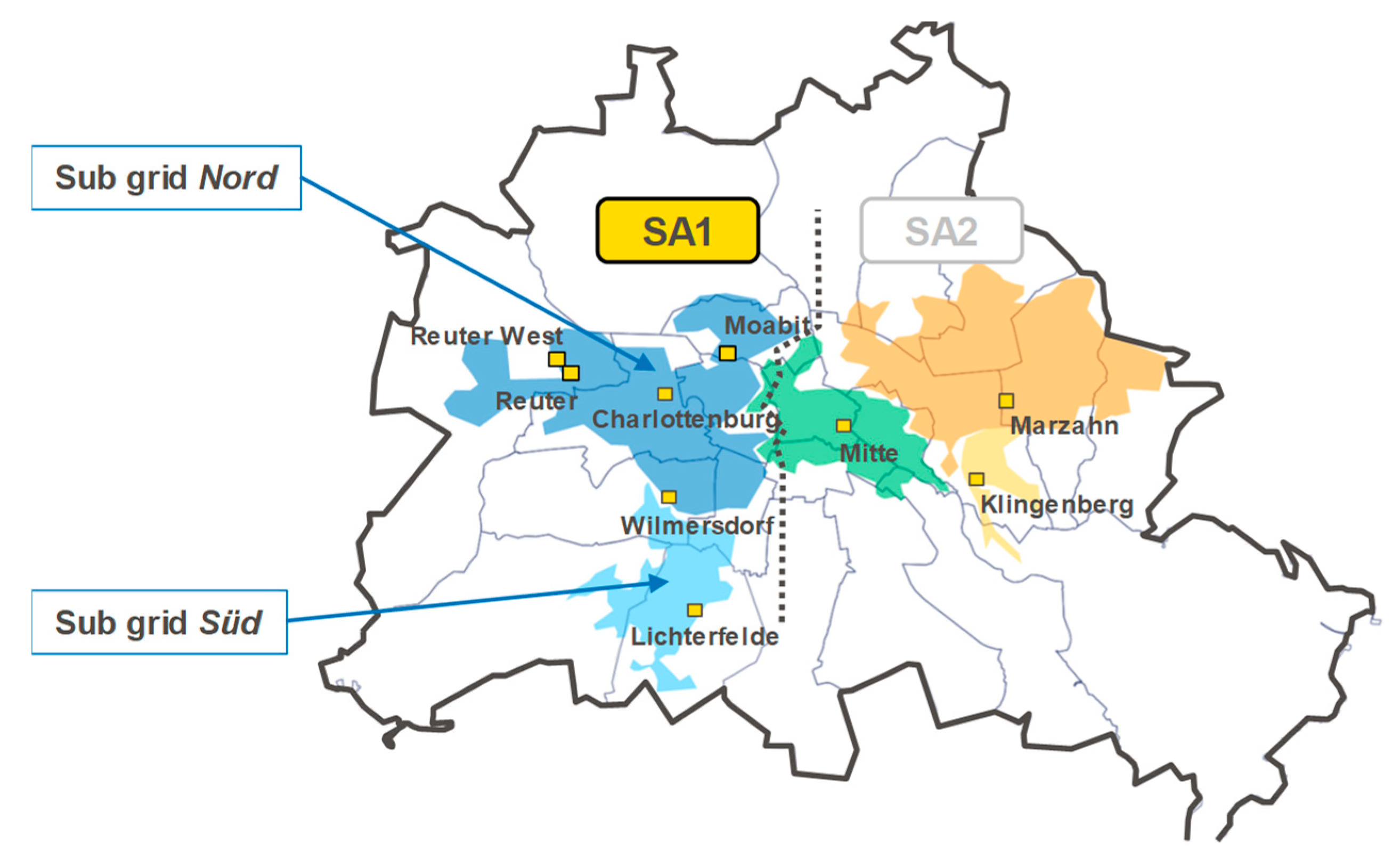
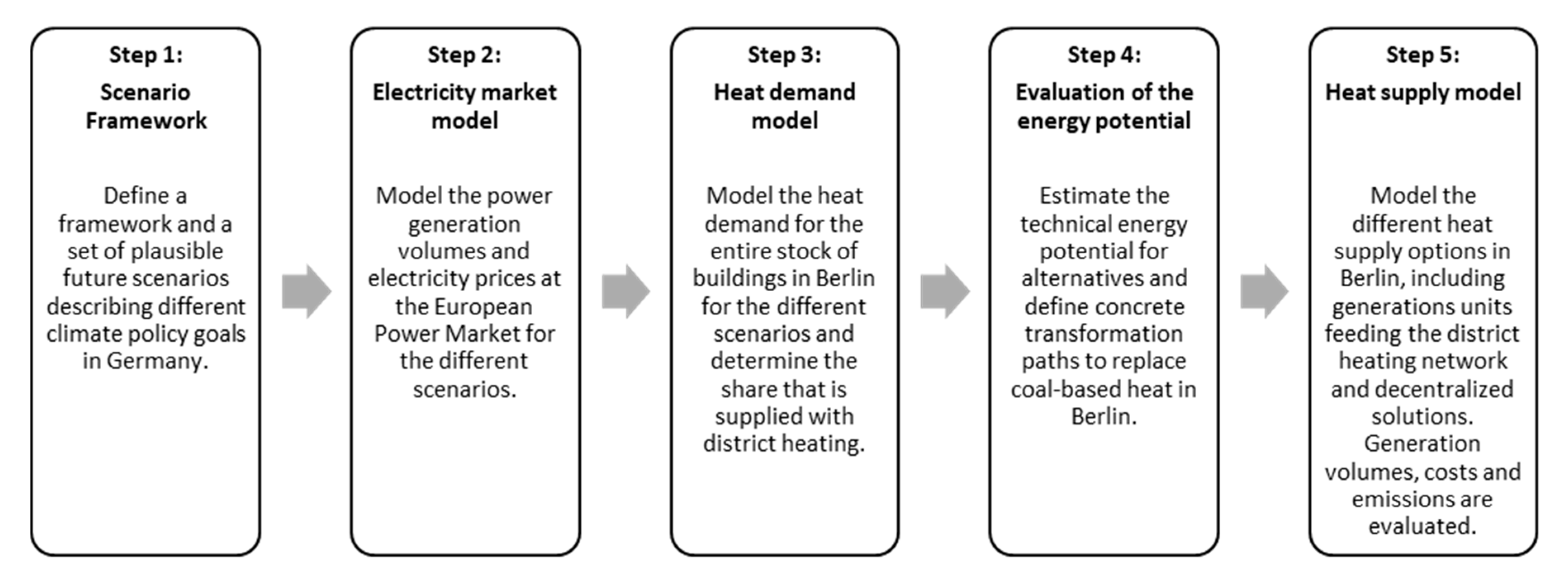
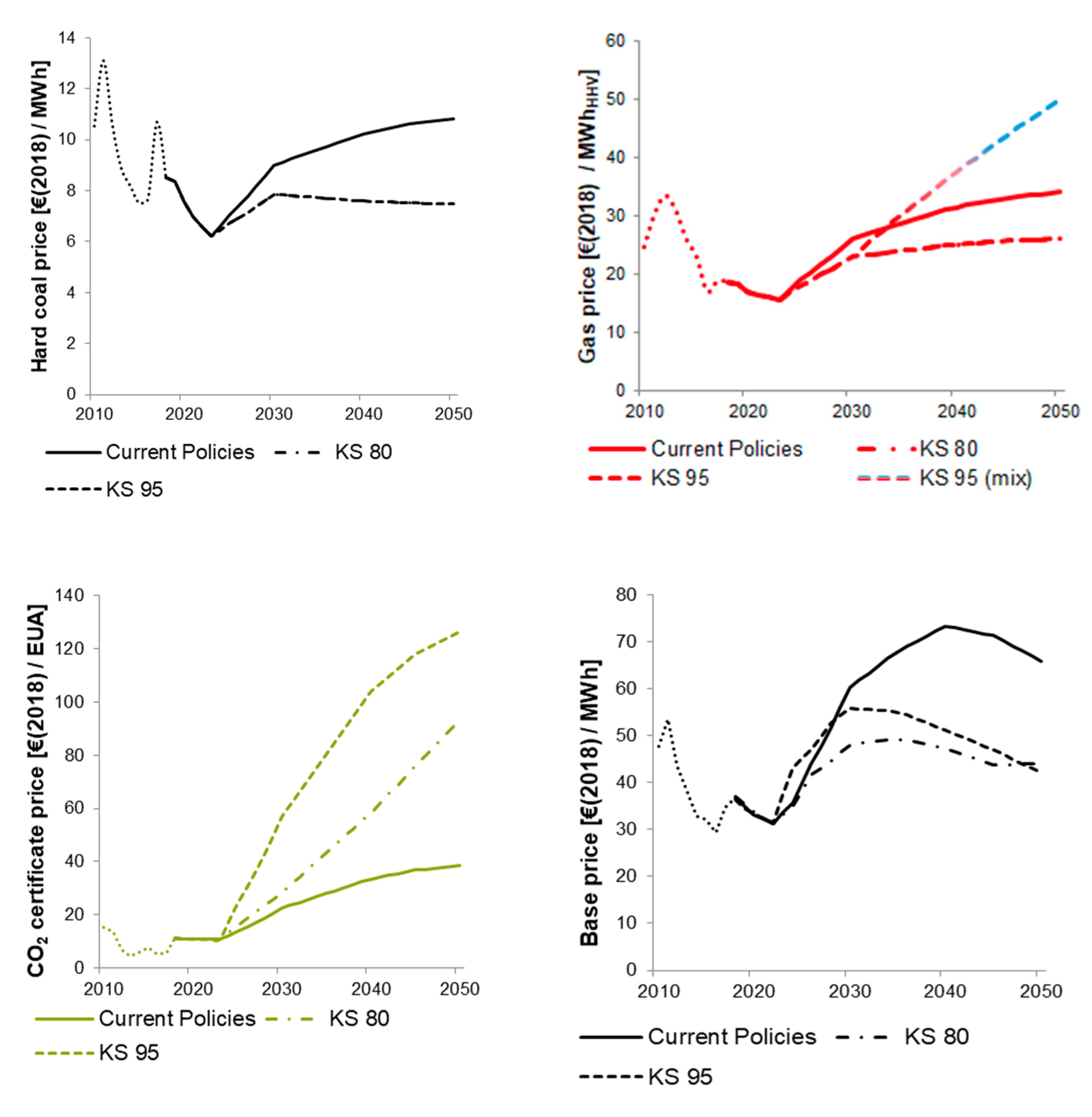

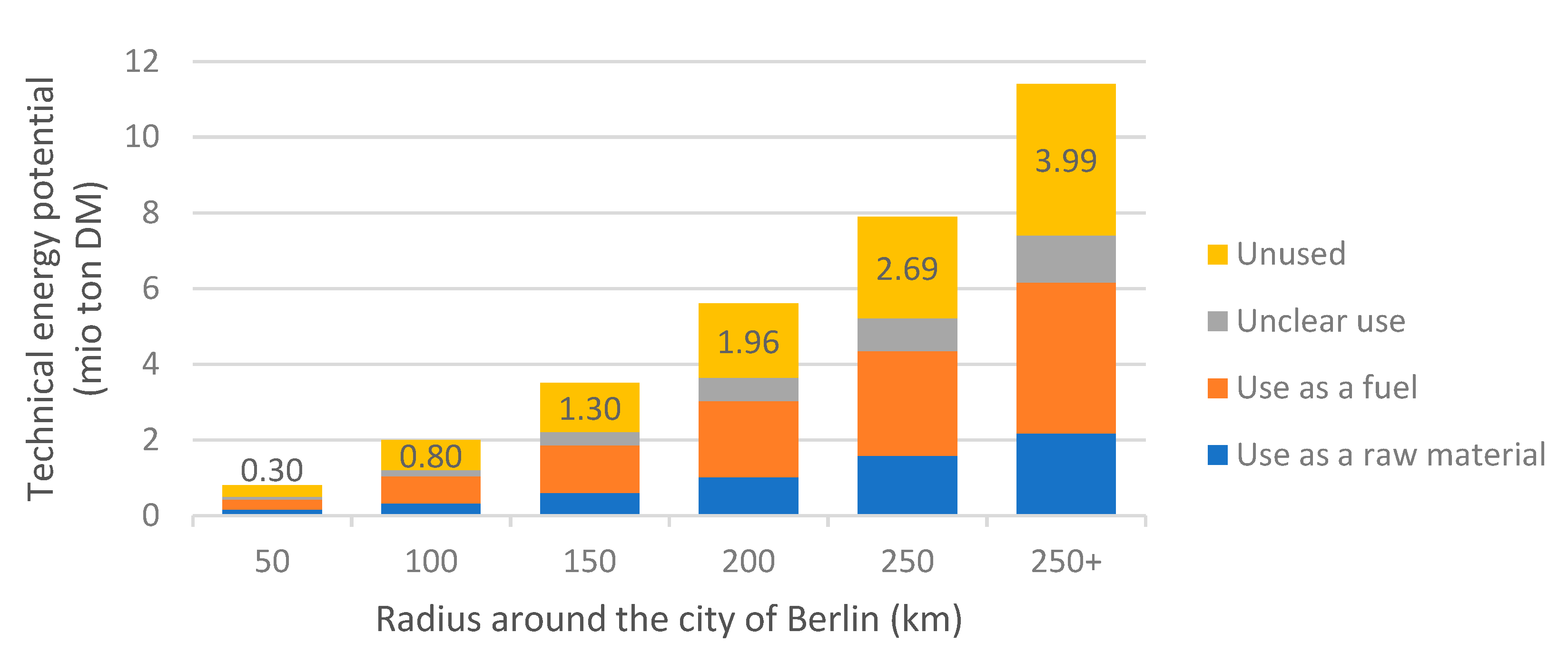

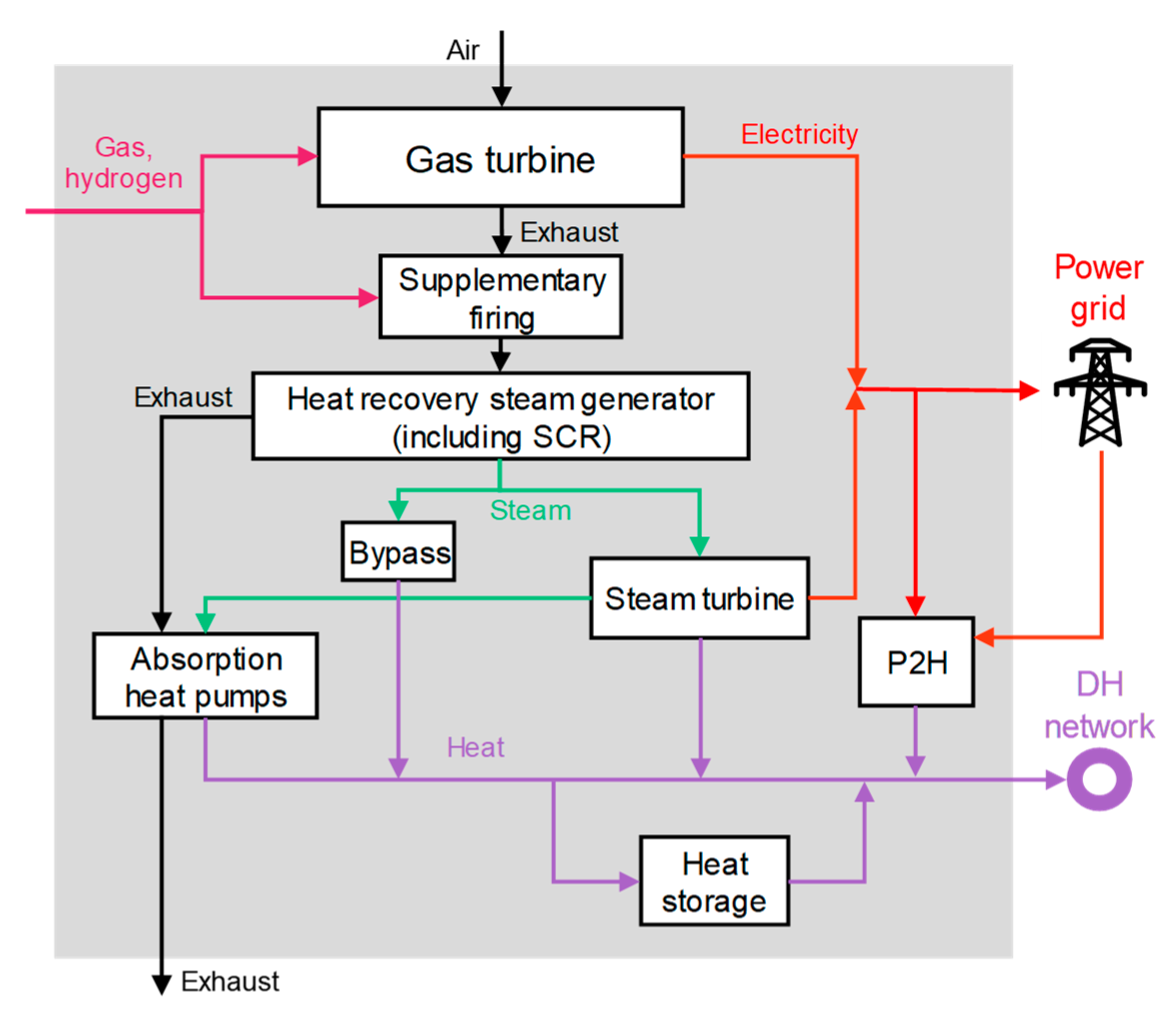
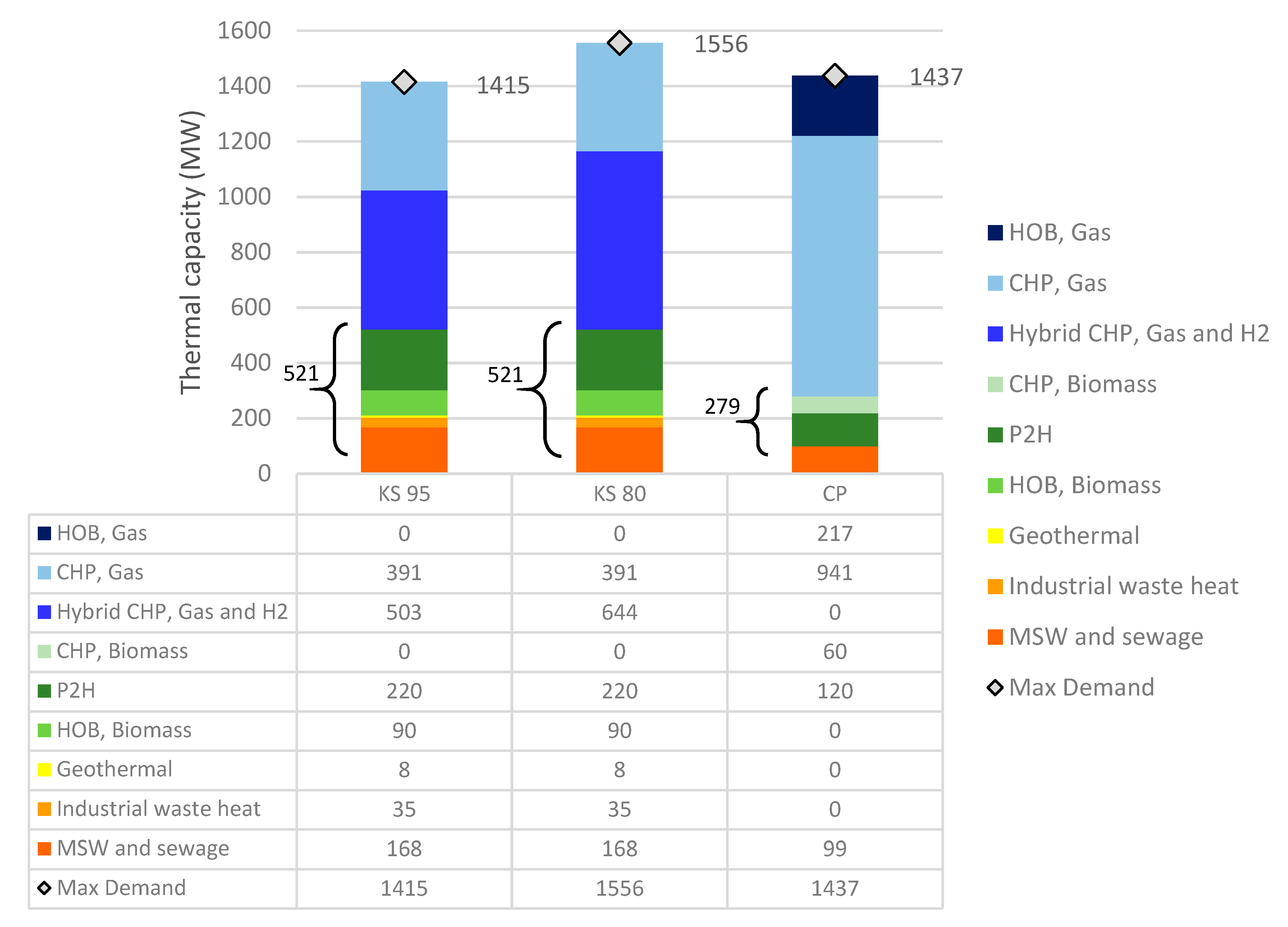
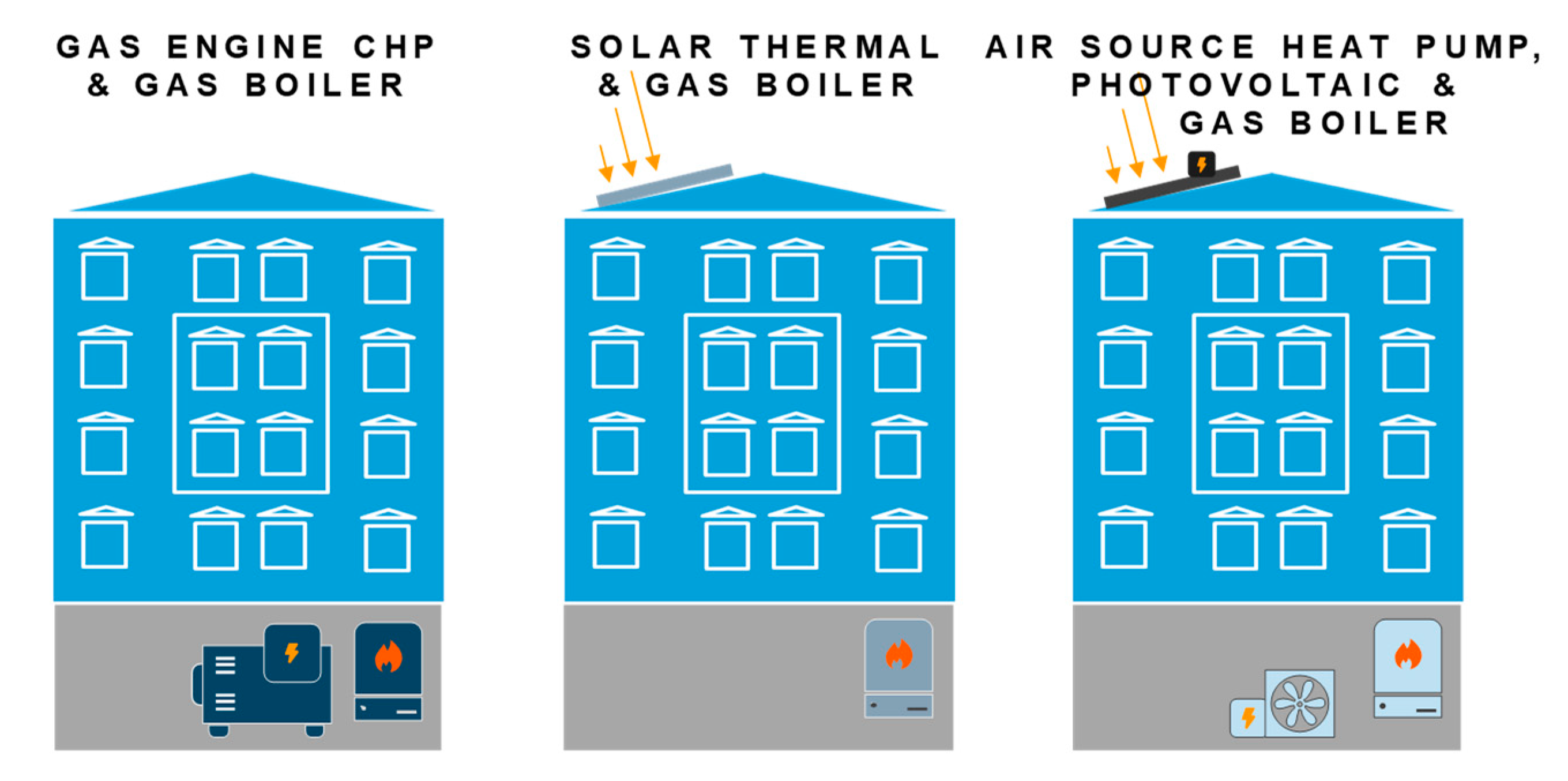
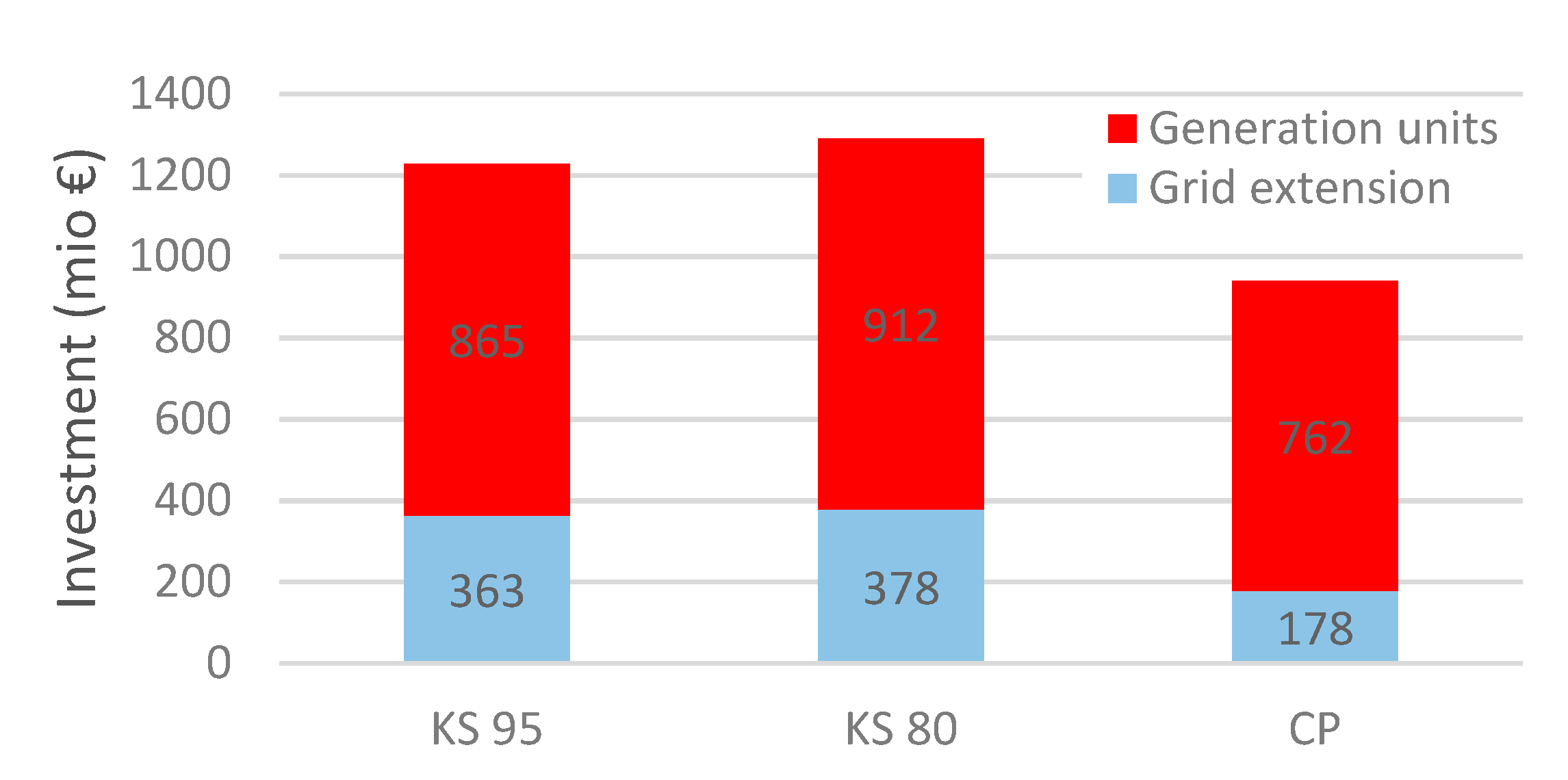
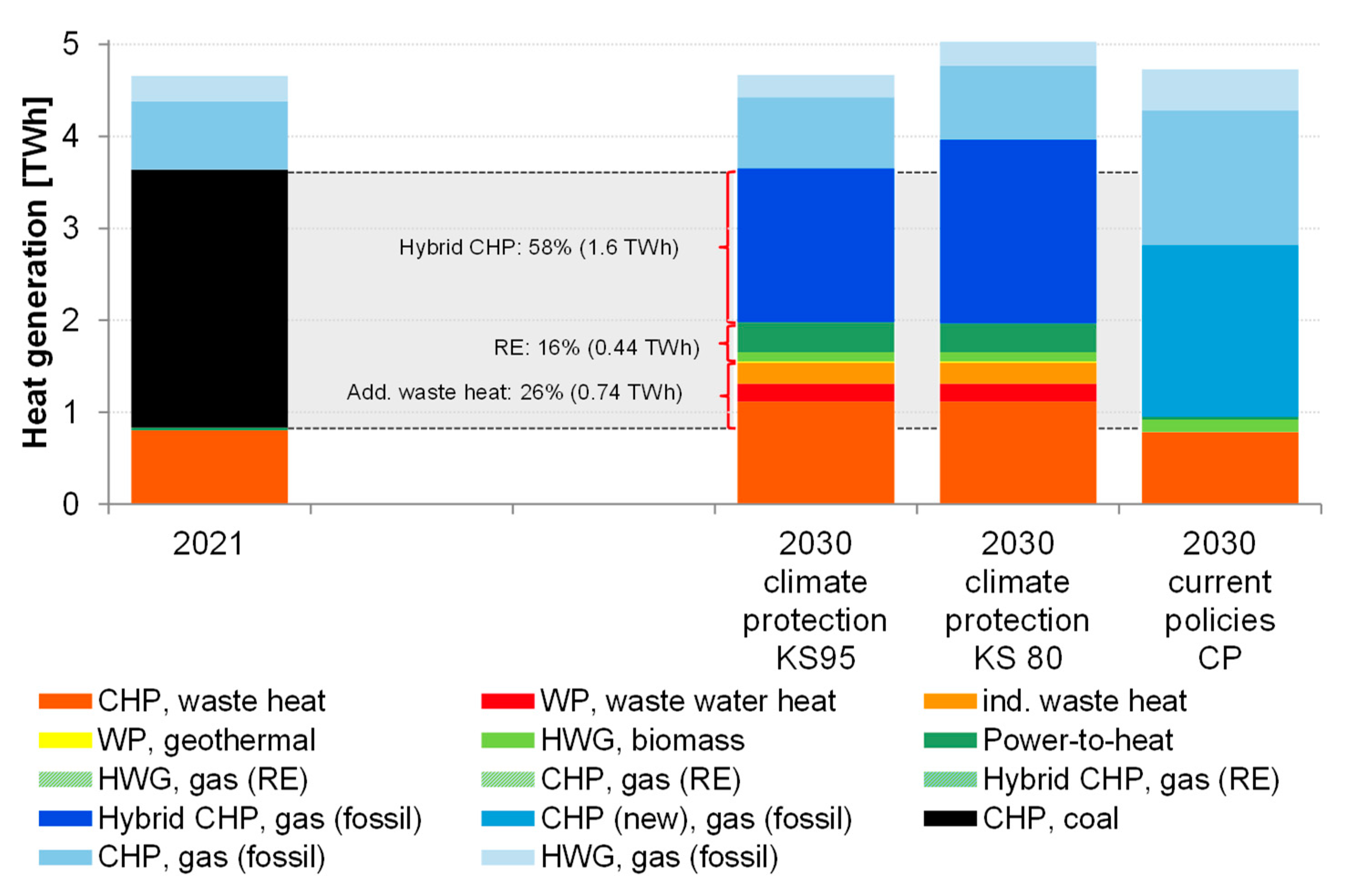
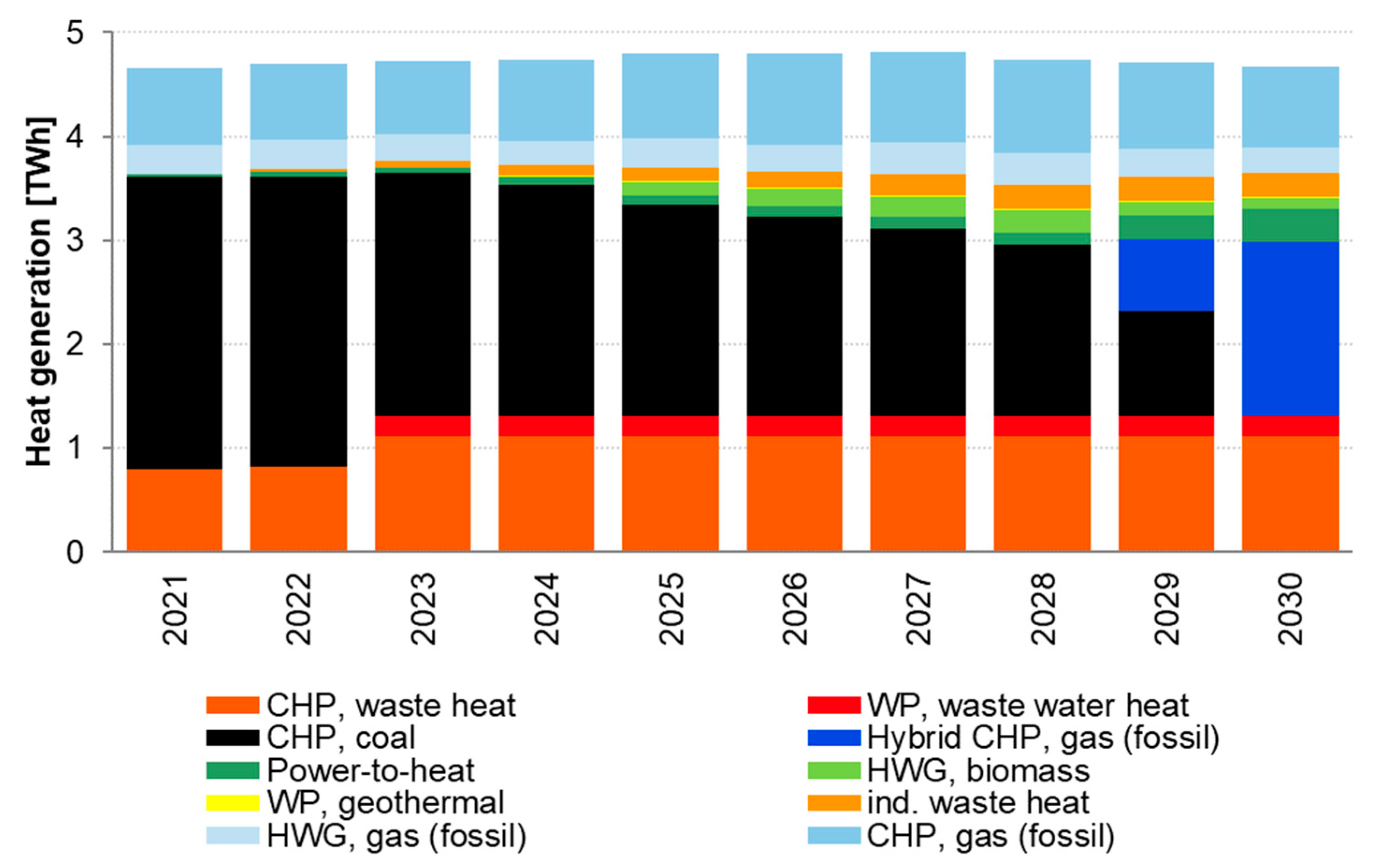
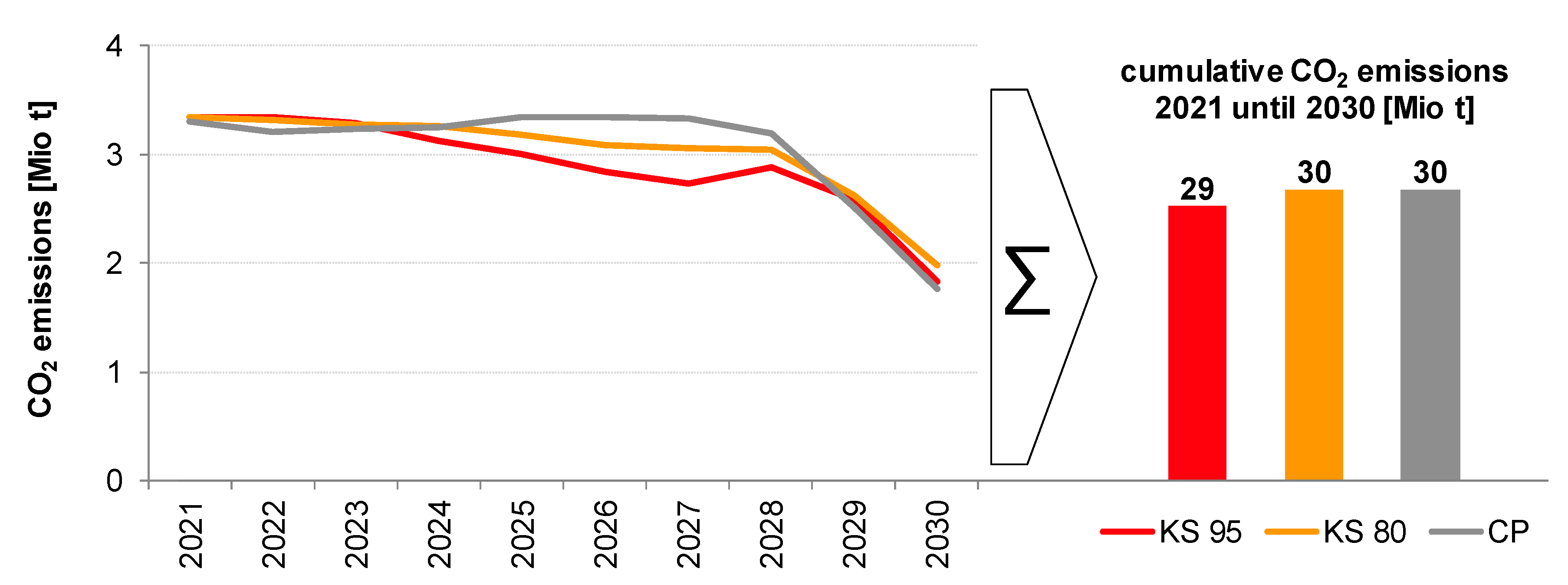
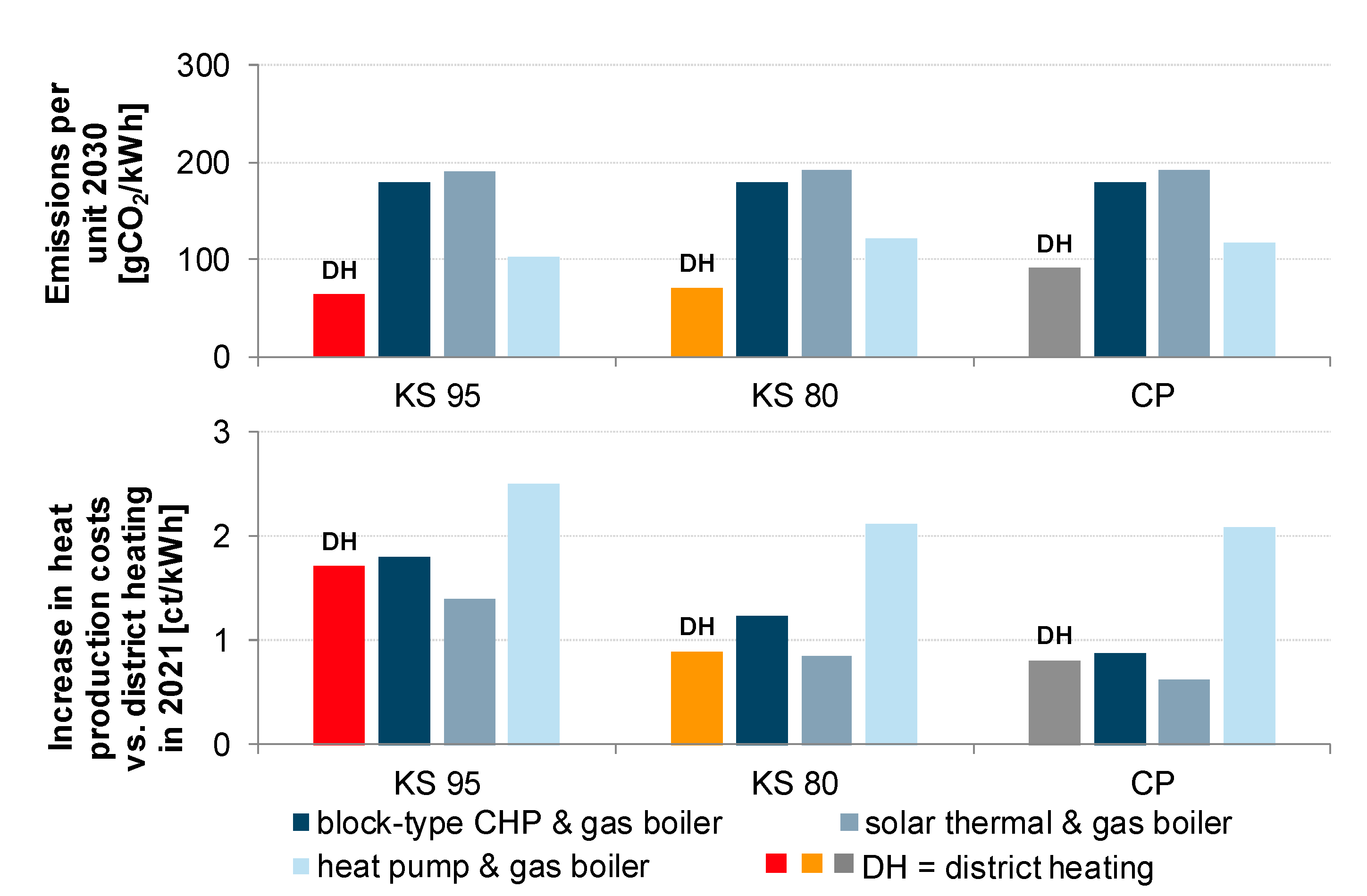
| Commercial Availability of Conversion Technologies | Space and Resource Availability | |||||
|---|---|---|---|---|---|---|
| Reuter | Reuter West | Moabit | Charlottenburg | Wilmersdorf | ||
| Biomass | Yes | Yes | Yes | Yes | No | No |
| Municipal solid waste | Yes | Yes | Yes | No | No | No |
| Industrial excess heat | Yes | Yes (not site-specific) | ||||
| Geothermal | Yes | Yes | Yes | Yes | No | No |
| Large-scale solar thermal | Yes | No | No | No | No | No |
| River water heat | Yes | Yes | Yes | No | Unlikely | No |
| Power-to-heat | Yes | Yes | Yes | Yes | Yes | Yes |
| Gas turbines | Yes 1 | Yes | Yes | Yes | Yes | Yes |
| Attractiveness | Number of Companies | Average Distance from Network (km) | Average Excess Heat Capacity (MW) | Estimated Excess Heat Capacity (MW) | Estimated Excess Heat Potential (GWh) |
|---|---|---|---|---|---|
| High | 27 | 2.9 | 2.3 | 65 | 294.8 |
| Medium | 21 | 1.5 | 2.4 | 50 | 312.3 |
| Low | 76 | 1.7 | 0.3 | 20 | 106.4 |
| Theoretical potential | 124 | 229.0 | 1.1 | 135 | 713.5 |
| Technical potential | 27 | 2.9 | 2.3 | 65 | 294.8 |
| Characteristics | Option 1 | Option 2 | Option 3 | Option 4 | Option 5 |
|---|---|---|---|---|---|
| Location | Reuter | Reuter | Moabit | Moabit | Moabit |
| Storage | No | Yes | No | Yes | Yes |
| Depth (m) | 1195 | 1195 | 1495 | 1495 | 310 |
| Annual heat production (GWh/year) | 19.6 | 18.3 | 20.7 | 18.5 | 28.7 |
| Resources | Overview | Suitable for Replacing Coal | Capacity (MWth) | ||
|---|---|---|---|---|---|
| KS 95 | KS 80 | CP | |||
| MSW and sewage | Technically and economically feasible. Advantages: multiple site synergies, available infrastructure, no emissions. | Yes | 168 | 168 | 99 |
| Industrial excess heat | Technically and economically feasible. Advantages: low-mid costs and no emissions. | Yes | 35 | 35 | 0 |
| Geothermal | Technically feasible at mid-high costs and with limited capacity. | Yes | 8 | 8 | 0 |
| Biomass | Technically and economically feasible. Advantages: diversification of the portfolio and reduction of emissions. | Yes | 90 | 90 | 60 |
| Hybrid CHP | Required to fill the gap between future heat capacity requirements and the potential from low carbon heat sources. Advantages: highly flexible and efficient, strong sector coupling with the potential to emit no emissions if green hydrogen or SNG are used. | Yes | 503 (CHP) | 644 (CHP) | 0 (CHP) |
| 220 (P2H) | 220 (P2H) | 120 (P2H) | |||
| River water heat | Technically unfeasible. Key disadvantage: strong imbalance between seasonal potential and seasonal demand. | No | 0 | 0 | 0 |
| Solar thermal | Technically and economically unfeasible. Large area requirements, which are currently not available. | No | 0 | 0 | 0 |
| Total capacity from low carbon sources | 521 | 521 | 279 | ||
Publisher’s Note: MDPI stays neutral with regard to jurisdictional claims in published maps and institutional affiliations. |
© 2020 by the authors. Licensee MDPI, Basel, Switzerland. This article is an open access article distributed under the terms and conditions of the Creative Commons Attribution (CC BY) license (http://creativecommons.org/licenses/by/4.0/).
Share and Cite
Gonzalez-Salazar, M.; Langrock, T.; Koch, C.; Spieß, J.; Noack, A.; Witt, M.; Ritzau, M.; Michels, A. Evaluation of Energy Transition Pathways to Phase out Coal for District Heating in Berlin. Energies 2020, 13, 6394. https://doi.org/10.3390/en13236394
Gonzalez-Salazar M, Langrock T, Koch C, Spieß J, Noack A, Witt M, Ritzau M, Michels A. Evaluation of Energy Transition Pathways to Phase out Coal for District Heating in Berlin. Energies. 2020; 13(23):6394. https://doi.org/10.3390/en13236394
Chicago/Turabian StyleGonzalez-Salazar, Miguel, Thomas Langrock, Christoph Koch, Jana Spieß, Alexander Noack, Markus Witt, Michael Ritzau, and Armin Michels. 2020. "Evaluation of Energy Transition Pathways to Phase out Coal for District Heating in Berlin" Energies 13, no. 23: 6394. https://doi.org/10.3390/en13236394
APA StyleGonzalez-Salazar, M., Langrock, T., Koch, C., Spieß, J., Noack, A., Witt, M., Ritzau, M., & Michels, A. (2020). Evaluation of Energy Transition Pathways to Phase out Coal for District Heating in Berlin. Energies, 13(23), 6394. https://doi.org/10.3390/en13236394







